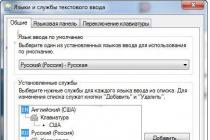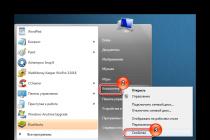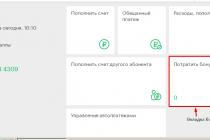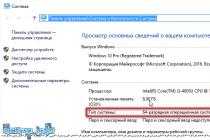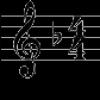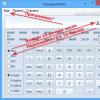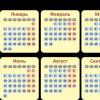Under informatics commonly understood as the branch of knowledge that studies general properties and the structure of information, as well as the laws and principles of its creation, transformation, accumulation, transmission and use in various fields of human activity on the basis of modern means of computing and telecommunications technology.
Word Informatics comes from the French word informatique, formed as a result of combining terms Information (information) and Automatic (automation), which expresses its essence as a science of automatic information processing
Except France term Informatics used in several Eastern European countries. At the same time, in most countries of Western Europe and the USA, a different term is used - Computer Science (the science of means computer science).
Two sciences are usually called as sources of the concept of "informatics" - documentaries and cybernetics.
Documentary was formed at the end of the 19th century in connection with the rapid development of industrial relations. It flourished in the 20s and 30s. XX century, and the main subject was the study of rational means and methods for improving the efficiency of workflow.
Fundamentals of technical science close to informatics cybernetics were laid down by the works on mathematical logic of the American mathematician Norbert Wiener, published in 1948, and the name itself comes from the Greek word ( kybemeticos- skillful in management).
First time term cybernetics was introduced by the French physicist André Marie Ampère in the first half of the 19th century. He was developing unified system classification of all sciences and designated by this term the science of management, which at that time did not exist, but which, in his opinion, should have existed.
Today, in practice, cybernetics in many cases relies on the same computer software and hardware as computer science, and computer science, in turn, borrows from cybernetics the mathematical and logical basis for the development of these tools.
The main attention in informatics is given to determining the main most effective automated technologies for working with information.
Computer science subject
Computer science subject are concepts such as:- computer equipment,
- software computer equipment,
- means and methods of human interaction with computer equipment and installed on them software tools(software),
- informational resources,
- methods and means of human interaction with information resources based on computer technology using appropriate software.
The concept of informatization of society
The activities of individuals, groups, teams and organizations now increasingly begin to depend on their awareness and ability to effectively use the available information. Before taking any action, it is necessary to do a lot of work on collecting and processing information, its comprehension and analysis. Finding rational solutions in any area requires the processing of large amounts of information, which is sometimes impossible without the involvement of special technical means.The increase in the volume of information became especially noticeable in the middle of the 20th century. An avalanche-like flow of information poured over a person, not giving him the opportunity to fully perceive this information. In the daily emerging new stream of information, it became increasingly difficult to navigate. Sometimes it has become more profitable to create a new material or intellectual product than to search for an analogue made earlier. The formation of large flows of information is due to:
- extremely rapid growth in the number of documents, reports, theses, reports, etc., which present the results of scientific research and development work;
- an ever-increasing number of periodicals in various fields of human activity;
- the emergence of various data (meteorological, geophysical, medical, economic, etc.), usually recorded on magnetic tapes and therefore not falling within the scope of the communication system.
- there are contradictions between the limited abilities of a person to perceive and process information and the existing powerful flows and arrays of stored information.
- there is a large amount of redundant information that makes it difficult to perceive useful information for the consumer;
- there are certain economic, political and other social barriers that hinder the dissemination of information.
These reasons gave rise to a very paradoxical situation - the world has accumulated a huge information potential, but people cannot use it in full due to their limited capabilities. The information crisis has put society in front of the need to find ways out of the current situation. The introduction of computers, modern means of processing and transmitting information in various fields of activity was the beginning of a new evolutionary process, called informatization, in the development of human society, which is at the stage of industrial development.
Under informatization of society it is commonly understood as an organized socio-economic and scientific-technical process of creating optimal conditions for meeting the information needs of citizens, public authorities, local governments, organizations, public associations based on the formation and use of information resources.
Informatization of society is one of the patterns of modern social progress. This term is sometimes replaced by the term "computerization of society". However, these are two very different terms.
At computerization of society the main attention is paid to the development and implementation of the technical base of computers that ensure the prompt receipt of the results of information processing and its accumulation.
At informatization of society the main attention is paid to a set of measures aimed at ensuring full use reliable, exhaustive and timely knowledge in all types of human activity.
Thus, "informatization of society" is a broader concept than "computerization of society", and is aimed at the speedy mastery of information to meet their needs. In the concept of “informatization of society”, the emphasis should be placed not so much on technical means as on the essence and goals of socio-technical progress. Computers are the basic technical component of the process of informatization of society.
Informatization infrastructure includes:
- communication systems,
- computers and networks,
- the software of these systems;
- information means;
- personnel training system for the operation of hardware, software and information support;
- economic and legal mechanisms that ensure and promote the effective development of the informatization process.
Concepts, types and features of information
In practice, definitions of such concepts as "information", "data", "knowledge" are often identified. However, these concepts must be distinguished.Data carries information about events that have occurred in the material world, and is a registration of signals that have arisen as a result of these events. However, data is not the same as information. Whether data becomes information depends on whether the method of transforming the data into known concepts is known.
þ For example, we can hear the speech of a person addressing us, speaking in a foreign and unfamiliar language. On the one hand, we receive data from him in the form of sounds, but on the other hand, we could not receive any information from him, because. failed to understand the data transmitted to us. They were coded for us, but we did not know the decoding method.
The data that constitutes information has properties that unambiguously determine an adequate method for obtaining this information. Moreover, it is necessary to take into account the fact that information is not a static object - it changes dynamically and exists only at the moment of interaction between data and methods. At all other times it is in the data state. Information exists only at the time of the information process. The rest of the time it is contained in the form of data.
The same data may present different information at the time of consumption, depending on the degree of adequacy of the methods interacting with them.
By its nature, data is objective, as it is the result of registration of objectively existing signals caused by changes in material bodies or fields. Methods are subjective. Artificial methods are based on algorithms (ordered sequences of commands) compiled and prepared by people (subjects).
Data- are fixed in the form certain signals perceived facts of the world.
So, according to the definitions given in explanatory dictionaries , the term "information" means the following:
- information (Information) - the content of the message or signal; information considered in the process of their transmission or perception, allowing to expand knowledge about the object of interest [Terminological dictionary on the basics of computer science and computer technology. Ed. A.P. Ershov, N.M. Shansky. - Moscow.: Education, 1991.-159 p.].
- information - originally - information transmitted by some people to other people orally, in writing or in some other way (Big Soviet Encyclopedia. Moscow: Soviet encyclopedia. 1980.-1600 p.).
where I is the amount of information;
p i - probability of occurrence of the i-th signal;
n is the number of possible signals.
The minus sign is set so that the value of information is positive, since the probabilities are always less than or equal to 1. The formula shows the dependence of the amount of information on the number of events and on the probability of these events. The information is zero when only one event is possible. As the number of events increases, it increases and reaches its maximum value when the events are equally probable. With this understanding, information is the result of a choice from a set of possible alternatives. However, the mathematical theory of information does not cover all the richness of the content of information, since it does not take into account the content side of the message.
Information- data organized in a certain way, having meaning, significance and value for its consumer and necessary for making decisions, as well as for the implementation of other functions and actions.
Forms of existence of information :
- symbolic
- sound
- graphic (illustrative)
- video
Knowledge- this is the awareness and interpretation of certain information, taking into account the ways of its best use to achieve specific goals. The characteristics of knowledge are: internal interpretability, structurability, coherence and activity.
Thus, taking into account the foregoing, we can conclude that the fixed perceived facts of the surrounding world are data. When using data in the process of solving specific problems - appears information. The results of solving problems, true, verified information (information), generalized in the form of laws, theories, sets of views and ideas is knowledge.
Those objects or devices from which a person can receive information are called sources of information.
Those objects or devices that can receive information are called receivers of information.
Information properties
Attribute properties are those properties without which information does not exist. This category of properties includes:- the inseparability of information from the physical carrier and the linguistic nature of information . One of the most important areas of informatics as a science is the study of the characteristics of various media and languages of information, the development of new, more advanced and modern ones. It should be noted that although information is inseparable from the physical carrier and has a linguistic nature, it is not rigidly associated with either a specific language or a specific carrier.
- discreteness. The information contained in the information, knowledge is discrete, i.e. characterize individual factual data, patterns and properties of the objects under study, which are distributed in the form of various messages consisting of a line, a composite color, a letter, a number, a symbol, a sign.
- continuity. Information tends to merge with the already recorded and accumulated earlier, thereby contributing to the progressive development and accumulation.
- meaning and novelty . This property characterizes the movement of information in social communications and highlights that part of it that is new to the consumer.
- utility. Reducing the uncertainty of information about the object. Disinformation is regarded as negative values of useful information.
- value. The value of information is different for different consumers and users.
- cumulative. Characterizes the accumulation and storage of information.
- completeness. characterizes information quality and defines adequacy data to make decisions or to create new data based on existing ones. The more complete the data, the wider the range of methods that can be used, the easier it is to choose a method that introduces a minimum of errors into the course of the information process.
- authenticity. Data occurs at the time of signal registration, but not all signals are "useful" - there is always some level of extraneous signals, as a result of which useful data is accompanied by a certain level of "information noise". If the useful signal is registered more clearly than extraneous signals, the reliability of the information may be higher. As the noise level increases, the reliability of information decreases. In this case, either more data or more sophisticated methods are required to convey the same amount of information.
- adequacy - this is the degree of correspondence with the real objective state of affairs. Inadequate information can be generated when new information is created based on incomplete or inaccurate data. However, both complete and reliable data can lead to the creation of inadequate information if inadequate methods are applied to them.
- availability(a measure of the possibility of obtaining this or that information). The degree of accessibility of information is influenced both by the availability of data and the availability of adequate methods for their interpretation. Lack of access to data or lack of adequate methods of data processing lead to the same result: the information is not available. The lack of adequate methods for working with data in many cases leads to the use of inadequate methods, resulting in incomplete, inadequate or unreliable information.
- relevance(the degree of correspondence of information to the current moment in time). Often, the commercial value of information is associated with relevance, as well as with completeness. Since information processes are extended in time, reliable and adequate, but outdated information can lead to erroneous decisions. The need to find (or develop) an adequate method for working with data can lead to such a delay in obtaining information that it becomes irrelevant and unnecessary. In particular, this is the basis for many modern systems data encryption with public key. Persons who do not own the key (method) for reading data can search for the key, since the algorithm for its operation is available, but the duration of this search is so long that during the work the information loses its relevance and, accordingly, the practical value associated with it.
- objectivity and subjectivity. The concept of objectivity of information is relative. This is understandable given that the methods are subjective. More objective information is considered to be the information in which the methods introduce a smaller subjective element. In the course of the information process, the degree of objectivity of information always decreases. This property is taken into account, for example, in legal disciplines, where the testimony of persons who directly observed events or received information indirectly (through inference or from the words of third parties) is processed differently.
- information growth . The movement of information in information communications and its constant distribution and growth determine the property of multiple distribution or repetition. Although information is dependent on a particular language and a particular carrier, it is not strictly associated with either a particular language or a particular carrier. Thanks to this, information can be obtained and used by several consumers. This is the property of reusability and the manifestation of the property of dissemination of information across various sources.
- aging . Information is subject to the influence of time.
Basic requirements for the quality of information
Information requirements include the following:
- timeliness;
- reliability (with a certain probability);
- adequacy;
- reliability (with a certain degree of risk);
- completeness of the information system;
- targeting;
- legal correctness of information;
- repeated use;
- high speed of collection, processing and transmission;
- possibility of coding;
- relevance of information.
|
|
|
| Who is in the picture?
Hare? Duck? |
Who is in the picture? Hare? Duck? |
| |
|
| What information can be obtained from this picture? How many characters are shown here? Total 9 pcs. |
Information that is presented in the figure with visual distortions. ALL lines in the figure are PARALLEL |
| |
|
| Information that is presented in the figure with visual distortions. The figure is not a spiral, but a circle |
What is shown in this picture? What do you see - people look down from the balcony or do you see a fence near the lawn? |
The role of computer technology in the informatization process
Computers in the information society have become a natural part of it and an element of every person's daily life, although often we simply do not notice them. It is difficult today to find at least one area of human activity where computers were not used or one that did not at least indirectly depend on their use. Computers often differ from the well-established concept of computers over the years. It suffices to give an example of an ATM for dispensing cash, a control system modern car, digital camera, or just a microwave oven. All of them are computers in themselves, include them as their constituent elements.That is why, recently, the main components of the means that contribute to the processing of information are also consumer electronics(television, audio, video and other equipment), which is beginning to play an increasing role in the economic life of individual members information society, acting as the most important terminal devices for receiving / transmitting and accumulating data, information and knowledge.
Electronic computers (computers), or, as they are increasingly called, computers (from the English word COMPUTE - calculate, count), are one of the most amazing creations of man. The simplest devices for facilitating counting appeared in ancient times, several millennia ago. As human civilization developed, they slowly evolved, constantly improving.
However, it was only in the 1940s that the foundation was laid for the creation of computers of modern architecture and with modern logic - modern electronic computers. Since then, in a historically very short period of time, computers - thanks to the tremendous advances in electronics - have come a way in their technical improvement and the scale of application and impact on human society, which cannot be compared with any other invention of mankind, including atomic energy and space technology. And the latter could not have received such a powerful development without the use of the achievements of computer technology.
Briefly characterizing the pace of development of computer technology, we can refer to a figurative comparison in the journal Scientific American (December 1982): The 767 would cost $500, circle the globe in 20 minutes and use 5 gallons (about 20 liters) of fuel." These figures very clearly reflect the relative reduction in cost, the increase in speed and the increase in the efficiency of computers.
However, with the advent of computers, new problems arose, the existence of which was not previously known.
The computer is primarily a MACHINE - not existing in nature, but a man-made object designed to enhance the natural capabilities of a person. Unlike tools, devices and mechanisms, a computer, like any machine, does not use the physical strength (energy) of a person for its functioning. When working with any machine, a person performs only a control function.
A computer is a special - COMPUTING, information machine that enhances not the physical capabilities of a person, but his ability to calculate, accumulate and process information, perform various kinds of calculations or facilitate this process.
A computer is an ELECTRONIC computer, the main functional elements of which are made (implemented, built, implemented) on electronic devices, using the most modern advanced signal processing technology, based on the use of electronics achievements. Theoretically, it is possible to build computers on a different material basis: history knows mechanical ones, our contemporaries - electronic and optical ones, and futurists - biological computers.
According to the way information is presented, computers are divided into three groups:
- analog computers(AVM), in which information is presented in the form of continuously changing variables expressed by any physical quantities;
- digital computers(TsVM), in which information is presented in the form of discrete values of variables (numbers), expressed as a combination of discrete values of any physical quantity (numbers);
- hybrid computers, which use both ways of presenting information.
With the development of networks since the early 70s, the list of services they provide is expanding and their intellectual level is increasing.
The most common services provided by modern networks include:
- Telecommunication services:
- messaging in “ Email”both between users of the same network and between users of different networks;
- messaging between participants of teleconferences and teleseminars;
- organization of electronic news bulletins (electronic bulletin boards);
- organization of dialogue and exchange of messages between two subscribers in the “request-response” mode;
- transfer of large arrays - files;
- reproduction of messages and their transmission according to a pre-prepared list; priority service of messages according to urgency categories;
- organization of closed groups of subscribers (subnets) for mutual exchange of information only within the group;
- delivery of fax messages; message forwarding in case of a change in the address of the recipient of information;
- issuance of copies of messages at the request of subscribers, etc.
- Information Services:
- search for information on issues of interest to subscribers
- Consulting services:
- consultations on information and software support of the network;
- consultations on the technology of using network resources;
- training in the skills of working with a computer and other technical means, etc.
- Technical Services:
- software installation, installation and testing of modems, etc.
- Advertising services: advertising in electronic conferences and seminars, on electronic bulletin boards.
JPAGE_CURRENT_OF_TOTAL
Lecture 1. Subject and basic concepts of computer science
Signals- the result of energy exchange between physical bodies or fields. When signals interact with physical bodies, certain changes in properties occur in the latter - this phenomenon is called signal registration. Such changes can be observed, measured or fixed - in this case, new signals arise and are recorded, that is, data are formed.
Data- These are registered signals that are an integral part of the information. The physical method of registration can be any: mechanical movement of bodies. change in their shape or surface quality parameters, change in electrical, magnetic, optical characteristics, chemical composition and (or) nature of chemical bonds, change in state electronic system and much more. According to the registration method, data can be stored and transported on various types of media.
Data carriers- The most common storage medium, although not the most economical, is paper. On paper, data is recorded by changing the optical characteristics of its surface. Changing the optical properties (changing the reflectance of the surface in a certain wavelength range) are also used in devices that record with a laser beam on plastic media with a reflective coating. As media using the change in magnetic properties, we can name magnetic tapes and disks. Recording data by changing the chemical composition of the carrier's surface substances is widely used in photography. At the molecular level, there is an accumulation and transmission of data in wildlife.
Any carrier can be characterized by the parameter resolution(the amount of data recorded in the unit of measurement adopted for the media) and dynamic range(logarithmic ratio of the intensity of the amplitudes of the maximum and minimum recorded signals). Such properties of information as completeness, accessibility and reliability often depend on these properties of the carrier.
Information
Information- this is a set of data (registered signals), which is perceived from the environment, is issued in environment or stored within a particular system. Information exists in the form of documents, drawings, drawings, texts, sound and light signals, electrical and nerve impulses, etc.
The most important properties of information:
- Oobjectivity and subjectivity of information- the concept of objectivity of information is relative. This is understandable, given that the methods of processing or collecting information themselves are subjective. More objective information will be the information in which the methods introduce a smaller subjective element. As an example, consider a photograph and a drawing made by a person of the same natural object. It is clear that the camera is impartial and will take an objective picture, unlike a person who can embellish or, on the contrary, worsen the appearance of an object, having his own subjective attitude towards it;
- completeness of information- largely characterizes the quality of information and determines the sufficiency of data for decision-making or for creating new data based on existing ones. The more complete the data, the wider the range of methods that can be used, the easier it is to choose a method that introduces a minimum of errors in the course of the information process;
- reliability of information- data occurs at the time of registration of signals, but not all registered signals are necessary. There is always some level of extraneous signals, resulting in the formation of "information noise"". The lower the “noise” level, the more reliable the received information;
- adequacy of information is the degree of correspondence with the real state of affairs. Inadequate information can be generated when new information is created based on incomplete or inaccurate data. However, both complete and reliable data can lead to the creation of inadequate information if inadequate processing methods are applied to them;
- availability of information- a measure of the possibility of obtaining this or that information. The degree of accessibility of information is influenced both by the availability of data and the availability of adequate methods for their interpretation. Lack of access to data or lack of adequate data processing practices leads to inaccessibility of information. The lack of adequate methods for working with data in many cases leads to the use of inadequate methods, resulting in incomplete, inadequate or unreliable information;
- relevance of information is the degree to which the information corresponds to the current moment in time. Since information processes are extended in time, reliable and adequate, but outdated information can lead to erroneous decisions. The need to find an adequate method for working with data can lead to such a delay in obtaining information that it becomes irrelevant and unnecessary.
Informatics, documentary and cybernetics.
Informatics- this is a complex, technical science that systematizes the methods of creating, storing, reproducing, processing and transmitting data by means of computer technology, as well as the principles of functioning of these tools and methods of managing them.
The emergence of informatics is due to the emergence and spread of a new technology for collecting, processing and transmitting information related to fixing data on various types of media.
As the primary sources of computer science, two sciences are usually called - documentary and cybernetics.
The term "computer science" comes from the French word Informatique, formed as a result of the combination of the terms Informacion (information) and Automatique (automation). In English-speaking countries, the term is used - Computer Science (the science of computer technology). Now these terms are synonymous and are used to refer to the science of information transformation, which is based on the use of computer technology.
Documentary- science, the main subject of which is the study of rational means and methods for improving the efficiency of document management.
Cybernetics(from the Greek kybernetike - the art of management, from kybernao - I drive, I manage), the science of management, communication and information processing. The subject of cybernetics are the principles of construction and operation of systems automatic control, and the main tasks are methods for modeling the decision-making process by technical means, the connection between human psychology and mathematical logic, the connection between the information process of an individual and information processes in society, the development of principles and methods of artificial intelligence.
Subject and main issue of informatics
Computer science is very close to technology, so its subject is often called information technology.
The subject of informatics as a science is:
- computer hardware;
- computer software;
- means of interaction between hardware and software;
- means of human interaction with hardware and software.
As you can see from this list, computer science pays special attention to interaction issues. Interaction in computer science is denoted by the term interface. Methods and means of human interaction with hardware and software are called - user interface. Accordingly, there are hardware, software and hardware-software interfaces.
The main task of informatics- this is a systematization of techniques and methods of working with hardware and software of computer technology.
The purpose of the systematization is to identify, implement and develop advanced, more efficient technologies for automating the stages of working with data, as well as methodically provide new technological research.
Informatics is a practical science. Its achievements should be tested in practice and accepted if they meet the criterion of increasing efficiency. As part of the main task today, the following main areas of informatics for practical application can be distinguished:
- architecture of computing systems (techniques and methods for building systems designed for automatic data processing);
- computer system interfaces (techniques and methods for controlling hardware and software);
- programming (techniques, methods and tools for developing complex tasks);
- data transformation (techniques and methods for transforming data structures);
- information protection (generalization of techniques, development of methods and means of data protection);
- automation (functioning of software and hardware without human intervention);
- standardization (ensuring compatibility between hardware and software, between formats for presenting data related to different types computing systems).
At all stages technical support information processes For informatics, efficiency is a key issue.
- Hardware efficiency is the ratio of hardware performance to its cost.
- Software efficiency is the productivity of users working with the corresponding software.
- Programming efficiency is volume program code created by the programmer per unit of time.
In computer science, everything is rigidly focused on efficiency. The question of how to carry out this or that operation for computer science is important, but not the main one. The main question of computer science is how to perform a given operation efficiently.
information process, informationsystem and information technology
Within the framework of computer science, as a technical science, it is possible to formulate the concepts of information, information system and information technology.
The information process is some of the actions when data is converted into information. Data processing includes many different operations, the main of which are:
- data collection - the accumulation of information in order to ensure sufficient completeness for decision-making;
- data formalization - bringing data that comes from different sources to a single form
- data filtering - elimination of unnecessary data that is not needed for decision making;
- data sorting - putting data in order according to a given attribute for the purpose of ease of use;
- data archiving - saving data in a convenient and accessible form;
- data protection - a set of measures aimed at preventing loss, reproduction and modification of data;
- data transportation - reception and transmission of data between remote users of the information process. The data source is usually called the server, and the consumer is called the client;
- data conversion - converting data from one form to another, or from one structure to another, or changing the media type.
Information system
In computer science, the concept of "system" is more often used in relation to a set of hardware and programs. The system is also called the hardware part of the computer. The addition of the concept of "system" with the word "information" reflects the purpose of its creation and functioning.
Informationalsystem- this is an interconnected set of means, methods and personnel used to store, process and issue information in order to solve a specific problem.
The modern understanding of the information system involves the use of a computer as the main technical means of information processing. Computers equipped with specialized software are technical base and information system tool.
In the work of the information system, the following stages can be distinguished:
- Origin of data- formation of primary messages that record the results of certain operations, the properties of objects and subjects of management, process parameters, the content of regulatory and legal acts, etc. -
- Accumulation and systematization of data- organization of their placement, which would provide a quick search and selection of the necessary information, methodical updating of data, protection of them from distortion, loss, deformation, etc.;
- Data processing- processes, as a result of which, on the basis of previously accumulated data, new types of data are formed: generalizing, analytical, recommendatory, forecasting. Derived data can also be processed to provide more generalized information;
- Data display- presenting them in a form suitable for human perception. First of all, this is printing, that is, the creation of documents on so-called hard (paper) media. The construction of graphic illustrative materials (graphs, diagrams) and the formation of sound signals are widely used.
Overwhelming majority information systems works in the mode of dialogue with the user. Typical software components of information systems include:
- dialog input-output subsystem;
- subsystem of applied data processing logic;
- data management logic subsystem.
Substantial part functionality information systems is embedded in the system software: operating systems, system libraries, and development tool constructs.
In addition to the software component of information systems important role plays an informational component that defines the structure, attributes and types of data, and is also closely related to the logic of data management.
For network information systems, an important element is a communication service that ensures the interaction of network nodes in the overall solution of the problem.
Information Technology
Technology- this is a way of mastering the material world by a person with the help of socially organized activity, which includes three components:
- informational (scientific principles and justification);
- material (tool of work);
- social (specialists with professional skills).
This triad is the essence of modern understanding - technology.
concept information technology appeared with the emergence of: the information society, the basis of social dynamics in which are not traditional material, but information resources: knowledge, science, organizational factors, intellectual abilities, initiative, creativity, etc. The most successful definition of the concept of information technology is given by academician Glushkov V.M., who interpreted it as human-machine technology for collecting, processing and transmitting information thatbasedon the use of computers. These technologies are rapidly developing, covering all types of social activities.
Subject and basic concepts of computer science
Informatics is a complex, technical science that systematizes the methods of creating, storing, reproducing, processing and transmitting data by means of computer technology, as well as the principles of operation of these tools and methods for managing them. The term "computer science" comes from the French word Informatique and is formed from two words: information and automation. This term was introduced in France in the mid-60s of the XX century, when computer technology began to be widely used. Then in the English-speaking countries the term "Computer Science" came into use to refer to the science of information transformation, which is based on the use of computer technology. Now these terms are synonymous.
The emergence of informatics is due to the emergence and spread of a new technology for collecting, processing and transmitting information related to fixing data on machine media.
The subject of informatics as a science is:
- computer hardware;
- computer software;
- means of interaction between hardware and software;
- means of human interaction with hardware and software.
Means of interaction in computer science is usually called an interface. Therefore, the means of interaction between hardware and software is sometimes also called the hardware-software interface, and the means of human interaction with hardware and software - the user interface.
The main task of informatics as a science is the systematization of techniques and methods of working with hardware and software of computer technology. The purpose of the systematization is to identify, implement and develop advanced, more efficient technologies for automating the stages of working with data, as well as methodically provide new technological research.
Informatics is a practical science. Its achievements should be tested in practice and accepted if they meet the criterion of increasing efficiency. As part of the main task today, the following main areas of informatics for practical application can be distinguished:
- architecture of computing systems (techniques and methods for building systems designed for automatic data processing);
- computer system interfaces (techniques and methods for controlling hardware and software);
- programming (techniques, methods and tools for developing complex tasks);
- data transformation (techniques and methods for transforming data structures);
- information protection (generalization of techniques, development of methods and means of data protection);
- automation (functioning of software and hardware without human intervention);
- standardization (ensuring compatibility between hardware and software, between data presentation formats related to different types of computing systems).
At all stages of the technical support of information processes for informatics, the key issue is efficiency. For hardware, efficiency refers to the ratio of equipment performance to its cost. For software, efficiency is usually understood as the productivity of users working with it. In programming, efficiency is understood as the amount of program code created by programmers per unit of time. In computer science, everything is rigidly focused on efficiency. The question of how to carry out this or that operation is important for computer science, but not the main one. The main question is how to perform this operation effectively.
Within the framework of informatics, as a technical science, it is possible to formulate the concepts of information, information system and information technology.
Information
Information is a set of information (data) that is perceived from the environment (input information), issued to the environment (input information) or stored within a particular system.
Information exists in the form of documents, drawings, drawings, texts, sound and light signals, electrical and nerve impulses, etc.
The most important properties of information:
- objectivity and subjectivity;
- completeness;
- authenticity;
- adequacy;
- availability;
- relevance.
Data is an integral part of information, which are registered signals.
During the information process, data is transformed from one form to another using methods. Data processing includes many different operations. The main operations are:
- data collection - the accumulation of information in order to ensure sufficient completeness for decision-making;
- data formalization - bringing data that comes from different sources to a single form;
- data filtering - elimination of unnecessary data that is not needed for decision making;
- data sorting - putting data in order according to a given attribute for the purpose of ease of use;
- data archiving - saving data in a convenient and accessible form;
- data protection - a set of measures aimed at preventing loss, reproduction and modification of data;
- data transportation - reception and transmission of data between remote users of the information process. The data source is usually called the server, and the consumer is called the client;
- data conversion - converting data from one form to another, or from one structure to another, or changing the type of media.
Information system
In computer science, the concept of "system" is more often used in relation to a set of hardware and programs. The system is also called the hardware part of the computer. The addition of the concept of "system" with the word "information" reflects the purpose of its creation and functioning.
Information system - an interconnected set of tools, methods and personnel used to store, process and issue information in order to solve a specific problem.
The modern understanding of the information system involves the use of a computer as the main technical means of information processing. Computers equipped with specialized software are the technical base and tool of the information system.
In the work of the information system, the following stages can be distinguished:
- The origin of data is the formation of primary messages that record the results of certain operations, the properties of objects and subjects of management, process parameters, the content of regulatory and legal acts, etc.
- Accumulation and systematization of data - the organization of such their placement, which would provide a quick search and selection of the necessary information, methodical updating of data, protecting them from distortion, loss, deformation of integrity, etc.
- Data processing - processes, as a result of which, on the basis of previously accumulated data, new types of data are formed: generalizing, analytical, recommendatory, predictive. Derived data can also be processed, obtaining more generalized information.
- Displaying data - presenting them in a form suitable for human perception. First of all, this is printing, that is, the creation of documents on the so-called hard (paper) media. The construction of graphic illustrative materials (graphs, diagrams) and the formation of sound signals are widely used.
The messages that are generated in the first step can be a regular paper document, a "machine-ready" message, or both. In modern information systems, mass messages for the most part have a "machine form". The equipment that is used in this case is called the means of recording primary information.
The needs of the second and third stages are satisfied in modern information systems mainly by means of computer technology. The means that ensure the availability of information for a person, that is, the means of displaying data, are components of computer technology.
The vast majority of information systems operate in a dialogue mode with the user. Typical software components of information systems include: a dialog input-output subsystem, a subsystem that implements the dialog logic, a subsystem for applied data processing logic, a subsystem for data management logic. For network information systems, an important element is a communication service that ensures the interaction of network nodes in the overall solution of the problem. A significant part of the functionality of information systems is embedded in the system software: operating systems, system libraries and development tool designs. In addition to the software component of information systems, an important role is played by the information component, which specifies the structure, attributes and types of data, and is also closely related to the data management logic.
Information Technology
In a broad sense, the word technology is a way for a person to master the material world with the help of socially organized activity, which includes three components: informational (scientific principles and justification), material (work tool) and social (specialists with professional skills). This triad is the essence of the modern understanding of the concept of technology.
The concept of information technology appeared with the emergence of the information society, the basis of social dynamics in which are not traditional material, but information resources: knowledge, science, organizational factors, intellectual abilities, initiative, creativity, etc. Unfortunately, this concept is so general and all-encompassing that until now experts have not come to a clear, formalized formulation. The most successful definition of the concept of information technology was given by Academician Glushkov V.M., who interpreted it as a human-machine technology for collecting, processing and transmitting information, which is based on the use of computer technology. This technology is rapidly developing, covering all types of social activities: production, management, science, education, financial and banking operations, medicine, everyday life, etc.
Control questions
What does computer science study?
What is meant by user interface?
What is information? What properties does she have?
What are the steps involved in data processing?
What is an information system?
What are the stages in the operation of information systems?
What is the meaning of the term "information technology"?
Informatics is a discipline based on the use of computer technology that studies the structure and general properties of information, as well as the patterns and methods of its creation, storage, search, transformation, transmission and application in various fields of human activity.
Term Informatics comes from the French word informatique and is formed from two words: information and automation. This term was introduced in France in the mid-1960s, when the widespread use of computing began. Then in English-speaking countries the term came into use computer science to designate the science of information transformation - a science based on the use of computer technology. Now these terms have become synonymous.
Tasks of informatics:
study of information processes of any nature;
development of information technology and creation latest technology processing information based on the results of the study of information processes;
solution of scientific and engineering creation problems, introducing and ensuring the effective use of computer equipment and technology in all spheres of public life.
As part of the main tasks of informatics today, the following main tasks can be distinguished: areas of informatics for practical use:
development of computing systems and software;
information theory, which studies the processes associated with the transmission, reception, transformation and storage of information;
mathematical modeling, methods of computational and applied mathematics and applied research in various fields of knowledge;
methods for developing artificial intelligence that simulate the methods of logical thinking and learning in human intellectual activity (logical inference, learning, speech understanding, visual perception, games, etc.);
bioinformatics, which studies information processes in biological systems;
social informatics, which studies the processes of informatization of society;
methods of computer graphics, animation, multimedia tools;
telecommunication systems and networks, including global computer networks that unite all of humanity into a single information community.
1.2. The concept of information
At the heart of the concept Informatics lies the term Information , which has various interpretations:
in everyday life, information is any data or information that interests someone;
in technology, information is understood as messages transmitted in the form of signs or signals;
in cybernetics, information is understood as that part of knowledge that is used for orientation, active action, control, i.e. in order to preserve, improve, develop the system.
There are other definitions as well.
Information - information about objects and environmental phenomena, their parameters, properties and state, which reduce the degree of uncertainty and incompleteness of knowledge about them.
In relation to computer data processing, information is understood as a certain sequence of symbolic designations (letters, numbers, encoded graphic images and sounds, etc.) that carries a semantic load and is presented in computer understandable form.
Information properties
Efficiency - reflects the relevance of information for the necessary calculations and decision-making in the changed conditions.
Accuracy - determines the permissible level of distortion of both source and result information, at which the efficiency of the system is maintained.
Reliability - is determined by the property of information to reflect real-life objects with the required accuracy.
Sustainability - reflects the ability of information to respond to changes in the source data without violating the required accuracy.
Sufficiency (completeness) - means that the information contains the minimum amount of information necessary to make the right decision. Incomplete information (not enough to make the right decision) reduces the effectiveness of the decisions made by the user; redundancy usually reduces efficiency and makes decision making more difficult, but makes information more stable.
Adequacy - it certain level correspondence of the image created with the help of information to a real object, process, phenomenon, etc.
Informatics - the science on methods of obtaining, accumulating, storing, transforming, transferring, protecting and using information. It includes disciplines related to information processing in computers and computer networks: how abstract like an analysis algorithms, and quite specific, for example, the development programming languages.
Informational resources- Various formalized knowledge (theories, ideas, inventions), data (including documents), technologies and means of their collection, processing, analysis, interpretation and application, as well as exchange between sources and consumers of information.
Information technology-1. A set of scientific disciplines involved in the study, creation and application of methods, methods, actions, processes, tools, rules, skills used to obtain new information (information, knowledge), collect, process, analyze, interpret, extract and apply data , content and information in order to meet the information needs of the national economy and society in the required volume and given quality.
Amount of Information can be considered as a measure to reduce the uncertainty of knowledge when receiving information messages.
The approach discussed above to information as a measure of reducing the uncertainty of knowledge makes it possible to measure information quantitatively. There is a formula that relates the number of possible information messages N and the amount of information I that the received message carries:
units of measurement of the amount of information. The minimum unit for measuring the amount of information is a bit, and the next largest unit is a byte, and:
1 byte = 8 bits = 2 3 bits.
In computer science, the system of education of multiple units of measurement is somewhat different from those accepted in most sciences. Traditional metric systems of units, such as the International System of Units SI, use a factor of 10 n as multiples of multiple units, where n = 3, 6, 9, etc., which corresponds to the decimal prefixes "Kilo" (10 3), "Mega" (10 6), "Giga" (10 9), etc.
In a computer, information is encoded using a binary sign system, and therefore, in multiple units of measuring the amount of information, the coefficient 2 n is used
So, units of measurement of the amount of information that are multiples of a byte are entered as follows:
1 kilobyte (KB) = 2 10 bytes = 1024 bytes;
1 megabyte (MB) = 2 10 KB = 1024 KB;
1 gigabyte (GB) = 2 10 MB = 1024 MB.
2. Definition of medical informatics as an applied science. Tasks solved by methods of medical informatics.
Medical Informatics is a science that studies the processes of receiving, transmitting, processing, storing, distributing, presenting information using information technology in medicine and healthcare.
The object of study of medical informatics are information technologies implemented in healthcare.
The main goal of medical informatics is to optimize information processes in medicine and healthcare through the use of computer technology, which improves the quality of public health care.
Tasks solved by medical informatics:
monitoring of the health status of different population groups, incl. patients of risk groups and persons with socially significant diseases
advisory support in clinical medicine (diagnosis, prognosis, treatment) based on computational procedures and (or) modeling of the logic of decision-making by doctors
transition to electronic medical records and outpatient medical records. cards, including payments for the treatment of insured patients (mandatory and voluntary insurance under various schemes)
automation of functional and laboratory diagnostics
Medical diagnostics
The development and implementation of information systems in the field of medical technology is a rather urgent task. An analysis of the use of personal computers in medical institutions shows that computers are mainly used for processing text documentation, storing and processing databases, and statistics. Part of the computer is used in conjunction with various diagnostic and therapeutic devices. In most of these areas of computer use, standard software is used - text editors, DBMS, etc. Therefore, the creation of an information organizational and technical system capable of timely and reliably establishing a patient's diagnosis and choosing an effective treatment strategy is an urgent task of informatization
Treatment management systems
The systems for managing the processes of treatment and rehabilitation include automated systems for intensive care, biological feedback, as well as prostheses and artificial organs created on the basis of microprocessor technology.
In treatment process control systems, the tasks of accurate dosing of quantitative parameters of work, stable retention of their set values under conditions of variability of the physiological characteristics of the patient's body come to the fore.
Automated intensive care systems are understood as systems designed to control the state of the body for therapeutic purposes, as well as to normalize it, restore the natural functions of the organs and physiological systems of a sick person, and maintain them within the normal range. According to the structural configuration implemented in them, intensive care systems are divided into two classes - systems program control and closed control systems.
Program control systems include systems for the implementation of therapeutic effects. For example, various physiotherapy equipment equipped with computer technology, devices for infusing drugs, equipment for artificial lung ventilation and inhalation anesthesia, heart-lung machines.
3. Network topologies. Examples. Specifications. Ethernet technology. Network topology is the geometric shape and physical arrangement of computers in relation to each other. Network topology allows you to compare and classify different networks. There are three main types of topology:
1) Star;
2) Ring;
BUS TOPOLOGY
When building a network according to a bus scheme, each computer is connected to a common cable, at the ends of which terminators are installed.
The signal passes through the network through all computers, reflecting from the end terminators.
The bus carries the signal from one end of the network to the other, with each workstation checking the address of the message, and if it matches the address of the workstation, it accepts it. If the address does not match, the signal goes further along the line. If one of the connected machines does not work, this does not affect the operation of the network as a whole, however, if the connection of any of the connected machines is disrupted due to a damaged contact in the connector or a cable break, a terminator malfunction, then the entire network segment (cable section between two terminators ) loses integrity, which leads to disruption of the entire network.
Advantages:
1) The failure of any of the workstations does not affect the operation of the entire network.
2) Simplicity and flexibility of connections.
3) Inexpensive cable and connectors.
4) A small amount of cable is needed.
5) Cable laying does not cause any particular difficulties.
Flaws
1) A broken cable, or other connection problems may prevent the normal operation of the entire network.
2) Limited cable length and number of workstations.
3) It is difficult to detect connection defects.
4) Low productivity.
5) When there is a large amount of data to be transmitted, the main cable may not be able to handle the information flow, resulting in delays.
TOPOLOGY "RING"
This topology is a series connection of computers, when the last is connected to the first. The signal travels around the ring from computer to computer in one direction. Each computer acts as a repeater, amplifying the signal and transmitting it further. Since the signal passes through each computer, the failure of one of them leads to the disruption of the entire network.
STAR TOPOLOGY
Star topology - a connection scheme in which each computer is connected to the network using a separate connecting cable. One end of the cable connects to the socket network adapter, the other is connected to a central device called a hub.
Installing a Zvezda topology network is easy and inexpensive. The number of nodes that can be connected to a hub is determined by the possible number of ports on the hub itself, however, there are limits on the number of nodes (maximum 1024). A working group created according to this scheme can function independently or can be associated with other working groups.
Advantages
1) Connecting new workstations does not cause any particular difficulties.
2) Ability to monitor the network and centrally manage the network
3) When using centralized network management, the localization of connection defects is simplified as much as possible.
4)Good extensibility and upgradeability.
Flaws
1) Failure of the hub leads to disconnection from the network of all workstations connected to it.
2) Sufficiently high cost of implementation, tk. a large amount of cable is required.
Local Ethernet network- a standard for organizing local computing systems used to connect devices located at a small distance from each other (in the same building, group of buildings).
An Ethernet network can have a bus or star topology. As a transmission medium, any type of cable can be used, as well as radio frequencies (radioEthernet).
The Ethernet specification provides several physical layer standards that define the type of cable systems and network topology in networking.
4. Open and closed source. Examples of OS open (OS) and closed source. List and characteristics of the advantages and disadvantages of OPS and proprietary operating systems Open source software (English open-source software) - open source software. The source code of such programs is available for viewing, studying and changing, which allows the user to take part in the finalization of the open program, use the code to create new programs and correct errors in them - by borrowing the source code, if license compatibility allows, or by studying the algorithms, data structures, technologies, techniques and interfaces used
Linux, Mozilla (Netscape browser engine), Apache (Web server), PERL (Web scripting language), and PNG (Format graphic files), there are many more examples of very popular open source software.
Closed source"- a program whose license does not fit the definition of open source software. As a rule, this means that only binary (compiled) versions of the program are distributed and the license implies no access to the source program code, which makes it difficult to create modifications to the program. Access to the source code to third parties is usually granted upon signing a non-disclosure agreement.
OS MS Windows, cons.
Relatively high cost. In the cheapest version, it is more than $ 50, despite the fact that such a "cheap" Windows, purchased with a new computer, is "tied" to this computer. And this means that when you change your computer, you will again have to spend money on Windows. The computer-independent versions of Windows are priced closer to $200 and up. And this is the cost of Windows for one computer. And if you need an OS, for example, for five computers that you already have (not new ones), you will have to pay for five copies of Windows about a thousand dollars.
A very large number malware(so-called computer viruses). For Windows versions XP is a particularly serious problem that imposes additional costs on the end user. Or to buy a good antivirus program or to contact specialists in cases where malware makes it impossible normal work Windows OS. This problem can be mitigated by expertly configuring Windows and using it carefully in risky situations, chief among them the Internet.
advantages and disadvantages of open source MS Windows, pros.
Support for a very large range of computer hardware. Whatever exotic piece of hardware you come across, you will almost certainly be able to use it under Windows. Although it may take you time to find the right driver program.
A huge number of application programs, today it is probably more than a hundred thousand titles. For any application task on the Windows platform, there are at least a few dozen; there are hundreds of programs for popular tasks. A large number of specialists who more or less well know the Windows OS family. That is, if you need help, you will find it easily and at a reasonable price.
GNU/Linux OS, pros.
Relatively low cost. In more or less big city it's quite possible to get a disk with any Linux distribution for the price of a blank CD/DVD by contacting Linux enthusiasts. You can also get a CD with an Ubuntu Linux distribution by mail for free. At the same time, having only one physical copy Linux distribution, you get the right to install it on any number of computers. So, going back to, say, five computers, if you buy one copy of a Linux distribution for $300, that's all your expenses for five computers—you don't have to buy five copies. So, on the one hand (Windows) about a thousand dollars, on the other hand (Linux) about 300 rubles (or even less than that).
The virtual absence, at least to date, of malware for this platform. This allows you to avoid additional costs for the prevention or elimination of damage from malware.
Developer Independence. If you need some functionality that is not available in the Linux OS, you can add it on your own. This possibility is due to the fact that the Linux OS is distributed not only in binary form, but also in source codes, and there are no prohibitions on modifying these source codes.
OS GNU/Linux, cons.
Significantly less than for Windows platforms, the number of application programs. Moreover, if we are talking about some programs - the undisputed leaders in their application areas, then under the Linux OS there are neither corresponding versions of these programs themselves, nor other programs comparable in functionality. Such application programs include Adobe products, 1C economic programs, AutoCAD engineering design program, text recognition programs (FineReader
Less than for the Windows platform, the number of good or decent specialists. That is, if you need help, then finding a person who is fairly well versed in Linux will not be so easy. It is quite possible that the cost of the services of such a specialist will be higher than in the case of Windows.
5. The concept of a software license, licensed and unlicensed software. Source. ishó this code(also ishó one text) - text computer program in any language programming or markup language that can be read by a human. In a generalized sense, any input for translator.
Facé nzia on the prograḿ mmnoe obespé reading is a legal instrument governing the use and dissemination software, protected copyright. Typically, a software license permits the recipient to use one or more copies of the program, and without the license, such use would be considered legally an infringement of the publisher's copyright.


